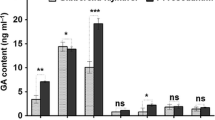Abstract
2,6-Diisopropylphenoxyacetic acid (DIPA), a promoter of growth and flowering of Sagittaria species, was found to improve the shoot growth of rice plants treated with uniconazole, an inhibitor of gibberellin (GA) biosynthesis. In a modified micro-drop bioassay using semi-dwarf rice, Oryza sativa L. cv. Tan-ginbozu, in which uniconazole had been incorporated into the agar medium, a significant recovery from growth inhibition was observed for both the 3rd and the 4th leaf sheaths but not for the 2nd sheath. In greenhouse experiments, uniconazole-treated rice plants partially recovered from growth inhibition when DIPA was applied after uniconazole treatment, whereas DIPA applied with, or before, uniconazole treatment did not improve growth. The levels of GA1 and GA20 in the rice plants treated with uniconazole plus DIPA were almost equal to those of the untreated controls, indicating that the observed growth recovery is attributable to the restoration of GA biosynthesis by DIPA.
Similar content being viewed by others
References
Devine MD, Duke SO and Fedtke C (1993) Physiology of Herbicide Action. Englewood Cliffs, NJ: PTR Prentice-Hall, pp 295–309
Graebe JE (1987) Gibberellin biosynthesis and control. Annu Rev Plant Physiol 38: 419–465
Hedden P (1990) The action of plant growth retardants at the biochemical level. In: Pharis RP and Rood SB (eds) Plant Growth Substances 1988. Berlin, Heidelberg, New York: Springer-Verlag, pp 322–332
Hofstra G, Krieg LC and Fletcher RA (1987) Uniconazole reduces ethylene and 1-aminocyclopropane-1-carboxylic acid and increases spermine levels in mung bean seedlings. J Plant Growth Regul 8: 45–51
Honda I, Sudo K, Iwasaki S, Yanagisawa T, Yamaguchi I, Kato H, Ikeda R, Hirasawa H and Takahashi N (1996) Characterization of endogenous gibberellins in dwarf rice mutants. Biosci Biotech Biochem 60: 2073–2075
Honma T, Yamaguchi I, Nakajima M, Murofushi N and Migita K (1995) Endogenous gibberellins in the pollen of Cryptomeria japonica D. Don. J Jpn For Soc 77: 358–365
Izumi K, Kamiya Y, Sakurai A, Oshio H and Takahashi N (1985) Studies of sites of action of a new plant growth retardant (E)-1-(4-chlorophenyl)-4,4-dimethyl-2-(1,2,4-triazol-1-yl)-1-penten-3-ol (S-3307) and comparative effects of its stereoisomers in a cell-free system from Cucurbita maxima. Plant Cell Physiol 26: 821–827
Izumi K, Nakagawa S, Kobayashi M, Oshio H, Sakurai A and Takahashi N (1988) Levels of IAA, cytokinins, ABA and ethylene in rice plants as affected by a gibberellin biosynthesis inhibitor, uniconazole-P. Plant Cell Physiol 29: 97–104
Izumi K, Yamaguchi I, Wada A, Oshio H and Takahashi N (1984) Effect of a new plant growth retardant (E)-1-(4-chlorophenyl)-4,4-dimethyl-2-(1,2,4-triazol-1-yl)-1-penten-3-ol (S-3307) on the growth and gibberellin content of rice plants. Plant Cell Physiol 25: 611–617
Kobayashi M, Sakurai A, Saka H and Takahashi N (1989) Quantitative analysis of endogenous gibberellins in normal and dwarf cultivars of rice. Plant Cell Physiol 30: 963–969
Kobayashi M, Yamaguchi I, Murofushi N, Ota Y and Takahashi N (1984) Endogenous gibberellins in immature seeds and flowering ears of rice. Agric Biol Chem 48: 2725–2729
Kobayashi M, Yamaguchi I, Murofushi N, Ota Y and Takahashi N (1988) Fluctuation and localization of endogenous gibberellins in rice. Agric Biol Chem 52: 1189–1194
Kuramochi H, Yoshimura T, Miyazawa T, Konnai M, Takematsu T and Yoneyama K (1996) Promotion of flowering in Sagittaria pygmaea Miq. by 2,6-diisopropylphenoxyacetic acid. Biosci Biotech Biochem 60: 374–375
Kuramochi H, Yoshimura T, Miyazawa T, Konnai M, Takematsu T and Yoneyama K (1996) Structural requirements of phenoxyalkanoic acids and related compounds for promotion of flowering in Sagittaria pygmaea Miq. J Agric Food Chem 44: 1906–1909
Kurogochi S, Murofushi N, Ota Y and Takahashi N (1979) Identification of gibberellins in rice and quantitative changes of gibberellin A19 throughout its life cycle. Planta 146: 185–191
Nishijima T and Katsura M (1989) A modified micro-drop bioassay using dwarf rice for detection of femtomol quantities of gibberellins. Plant Cell Physiol 30: 623–627
Preston C, Tardif FJ, Christopher JT and Powles SB (1996) Multiple resistance to dissimilar herbicide chemistries in a biotype of Lolium rigidum due to enhanced activity of several herbicide degrading enzymes. Pestic Biochem Physiol 54: 123–134
Sekimoto H, Miyata N, Katayama Y, Ohnishi J, Itoh S and Oshio H (1991) A new anti-lodging agent for rice, “Lomica”. Sumitomo Kagaku II: 38–53
Suzuki Y, Kurogochi S, Murofushi N, Ota Y and Takahashi N (1981) Seasonal changes of GA1, GA19 and abscisic acid in three rice cultivars. Plant Cell Physiol 22: 1085–1093
Tanno N, Yokota T, Abe m and Okagami N (1992) Identification of endogenous gibberellins in dormant bulbils of chinese yam, Dioscorea opposita. Plant Physiol 100: 1823–1826
Yamaguchi I, Nakazawa H, Nakagawa R, Suzuki Y, Kurogochi S, Murofushi N, Takahashi N and Weiler EW(1990) Identification and semi-quantification of gibberellins from the pollen and anthers of Zea mays by immunoassay and GC/MS. Plant Cell Physiol 31: 1063–1069
Yokota T, Nakamura Y, Takahashi N, Nonaka M, Sekimoto H, Oshio H and Takatsuto S (1990) Inconsistency between growth and endogenous levels of gibberellins, brassinosteroids, and sterols in Pisum sativum treated with uniconazole antipodes. In: Takahashi N, Phinney BO and MacMillan J (eds) Gibberellins. New York, Berlin, Heidelberg: Springer-Verlag, pp 339–349
Yoshimura T, Kuramochi H, Konnai M, Seto H, Sassa T and Yoneyama K (1997) Effects of plant growth regulators on shoot growth and flowering of a perennial paddy weed, Sagittaria pygmaea Miq. Biosci Biotech Biochem 61: 1896–1900
Author information
Authors and Affiliations
Rights and permissions
About this article
Cite this article
Noguchi, K., Kuramochi, H., Takeuchi, Y. et al. Restoration of gibberellin biosynthesis by 2,6-diisopropylphenoxyacetic acid in uniconazole-treated rice plants. Plant Growth Regulation 28, 67–72 (1999). https://doi.org/10.1023/A:1006215428363
Issue Date:
DOI: https://doi.org/10.1023/A:1006215428363




